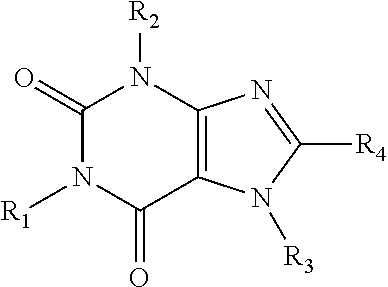Caffeinated compounds and compositions for treatment of amyloid diseases and synucleinopathies
a technology of amyloid diseases and compounds, applied in the field of caffeine compounds and compositions for the treatment of amyloid diseases and synucleinopathies, can solve the problems of toxicity and neuronal cell death, a heavy economic burden on society, and the overall cost of alzheimer's disease to families and to society is staggering
- Summary
- Abstract
- Description
- Claims
- Application Information
AI Technical Summary
Benefits of technology
Problems solved by technology
Method used
Image
Examples
example 1
Synthesis of the Compounds of the Invention
[0109]The compounds of this invention may be prepared by methods generally known to the person of ordinary skill in the art, having regard to that knowledge and the disclosure of this application including the Examples presented below.
[0110]The starting materials and reagents used in preparing these compounds are either available from commercial suppliers such as the Aldrich Chemical Company (Milwaukee, Wis.), Bachem (Torrance, Calif.), Sigma (St. Louis, Mo.), or Lancaster Synthesis Inc. (Windham, N.H.) or are prepared by methods well known to a person of ordinary skill in the art, following procedures described in such references as Fieser and Fieser's Reagents for Organic Synthesis, vols. 1-17, John Wiley and Sons, New York, N.Y., 1991; Rodd's Chemistry of Carbon Compounds, vols. 1-5 and supps., Elsevier Science Publishers, 1989; Organic Reactions, vols. 1-40, John Wiley and Sons, New York, N.Y., 1991; March J.: Advanced Organic Chemistry...
example 2
Compounds Disrupt / Inhibit Pre-Aggregated Parkinson's Disease α-Synuclein Fibrils
[0137]The compounds were found to be disrupters / disaggregators of α-synuclein fibrils. In this set of studies, the efficacy of certain compounds provided herein to cause a disassembly / disruption / disaggregation of pre-formed fibrils of Parkinson's disease (i.e. consisting of α-synuclein fibrils) was analyzed. For the studies described below in Parts A and B, 69 μM of α-synuclein (rPeptide, Bogart, Calif.) was first incubated at 37° C. for 4 days in 20 mM sodium acetate buffer at pH 4 with circular shaking (1,300 rpm) to cause α-synuclein aggregation and fibril formation.
Part A: Thioflavin T Fluorometry
[0138]In one study, Thioflavin T fluorometry was used to determine the effects of the compounds on α-synuclein fibrils. In addition to test compounds, this experiment included three control compounds (compounds 1, 2 and 3) for reference. In this assay Thioflavin T binds specifically to fibrillar protein, and...
example 3
Compounds Disrupt / Inhibit Freshly Dissolved Parkinson's Disease α-Synuclein Protein from Forming Fibrils (i.e. β-Sheet Secondary Structure)
Thioflavin T Fluorometry
[0145]To test whether the compounds can inhibit formation of α-synuclein β-sheet, the same assay as described in Example 2, was utilized but the α-synuclein was fresh and not pre-fibrillized. Fresh wild-type α-synuclein was dissolved in a buffer containing 9.5 mM phosphate, 137 mM sodium chloride and 2.7 mM potassium chloride (phosphate-buffered saline; PBS), and the pH was adjusted to pH 7.4. This solution was then lyophilized and dissolved in 1.0 ml deionized water at 0.5 mg / ml (35 μM). As indicated above the test compounds (typically at test compound:α-synuclein molar ratios of 10:1, 1:1, 0.1:1, and 0.01:1) were then added to the α-synuclein. Following 24-38 hours of co-incubation, the incubation mixtures were diluted 1:10 and 50 μl of each diluted incubation mixture was transferred into a 96-well microtiter plate conta...
PUM
| Property | Measurement | Unit |
|---|---|---|
| body weight | aaaaa | aaaaa |
| body weight | aaaaa | aaaaa |
| body weight | aaaaa | aaaaa |
Abstract
Description
Claims
Application Information
 Login to View More
Login to View More - R&D
- Intellectual Property
- Life Sciences
- Materials
- Tech Scout
- Unparalleled Data Quality
- Higher Quality Content
- 60% Fewer Hallucinations
Browse by: Latest US Patents, China's latest patents, Technical Efficacy Thesaurus, Application Domain, Technology Topic, Popular Technical Reports.
© 2025 PatSnap. All rights reserved.Legal|Privacy policy|Modern Slavery Act Transparency Statement|Sitemap|About US| Contact US: help@patsnap.com



